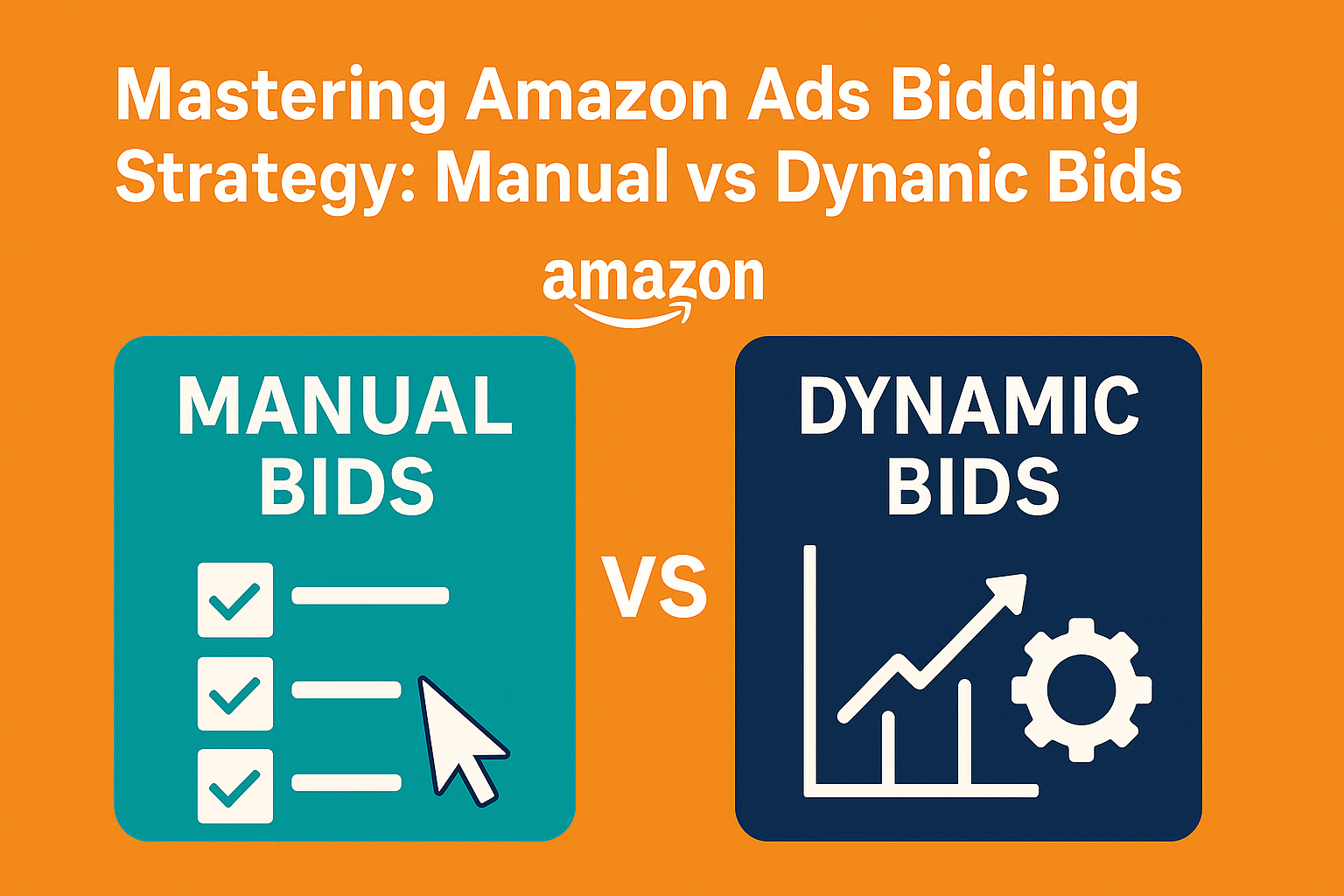- Perfality
- August 4, 2025
- 11:00 am
- Read Time: 5 mintues
Advertising on Amazon has become a central pillar for sellers aiming to grow their visibility and sales. But running ads successfully on Amazon isn’t just about launching campaigns. One of the most overlooked yet powerful aspects of success lies in understanding your Amazon ads bidding strategy. Whether you’re manually adjusting your bids or letting Amazon do the work through automation, your approach to bidding directly influences your ad performance—and ultimately your return on investment.
In this guide, we’re unpacking the core differences between manual bidding and dynamic bidding on Amazon, how to decide which approach works for your brand, and how a strategic partner like Perfality can help you avoid costly mistakes while scaling smartly.
Why Your Amazon Ads Bidding Strategy Matters
At its core, your bidding strategy on Amazon decides how much you’re willing to pay when someone clicks your ad. But it’s not just about setting a number—it’s about understanding the logic behind each option Amazon offers and choosing the one that supports your campaign goals.
A well-thought-out Amazon ads bidding strategy ensures you:
- Maintain profitability even in competitive niches
- Avoid overspending on low-return keywords
- Adjust your bids in real time as performance data rolls in
Too often, Amazon sellers rely on guesswork or default settings. The result? Budget burns quickly, and sales plateau. Whether you’re running Sponsored Products or Sponsored Brands, choosing the right approach between manual and dynamic bids could be what sets you apart.
Manual Bidding: Full Control, Higher Responsibility
Manual bidding gives you direct control over how much you bid on each keyword. If you’re someone who enjoys getting into the data and testing frequently, this method offers flexibility.
When manual bidding might work best:
- You’re managing a tight budget and want to ensure every dollar is spent intentionally
- You have a clear sense of which keywords convert and at what cost
- You need more precision during product launches or seasonal promotions
However, this approach demands consistent attention. Without regular analysis and bid adjustments, you may either overpay for underperforming clicks or underbid on high-performing search terms, losing valuable traffic.
That’s where tools and human insight intersect. Sellers often use software to monitor bid effectiveness, but having someone to interpret that data (and act on it) makes the real difference.
Dynamic Bidding: Automation with Built-In Logic
With dynamic bidding, Amazon adjusts your bid in real-time based on how likely a click is to lead to a sale. You still set a base bid, but Amazon will move that number up or down depending on what it thinks the outcome will be.
Two types of dynamic bidding:
- Down Only: Amazon lowers your bid when it thinks a conversion is less likely.
- Up and Down: Amazon increases your bid (up to 100%) when it believes there’s a strong chance of conversion, and decreases it when that likelihood drops.
When dynamic bidding makes sense:
- You want to save time managing daily optimizations
- You trust Amazon’s algorithm to handle real-time adjustments
- You’re okay with paying more in some cases for higher conversion potential
That said, giving full control to Amazon may lead to inefficiencies if you’re not actively monitoring results. You may end up paying more for clicks without fully understanding why. So, even with automation, strategic oversight remains key.
Comparing Both: Which Should You Choose?
There’s no one-size-fits-all answer. Your Amazon campaign bidding strategy should depend on your goals, product lifecycle stage, and how much time or expertise you can invest.
| Criteria | Manual Bidding | Dynamic Bidding |
| Control | High | Medium to Low |
| Optimization Required | Frequent | Minimal |
| Risk of Overspending | Moderate | High (with Up & Down) |
| Best For | Tight budgets, precise goals | Scaling, time-saving |
Many experienced sellers end up using a mix of both strategies, applying manual bidding to critical campaigns or high-priority keywords, and dynamic bidding for broader targeting.
Using Suggested Bids to Your Advantage
Amazon provides PPC suggested bids to help guide your decisions. These estimates are based on what other advertisers are bidding and what it typically costs to appear in top placements.
Don’t treat these suggestions as rules—but rather a helpful benchmark. You can bid slightly below or above depending on your product margin and desired visibility. Over time, you’ll gain a sharper understanding of how your Amazon PPC bidding strategy impacts impressions, click-through rates, and sales.
If you’re working with an Amazon PPC agency, they’ll typically combine historical data and market trends to make smarter adjustments instead of relying solely on Amazon’s suggestions.
How Perfality Helps Sellers Master Their Bidding Strategy
At Perfality, we don’t just manage ads—we dive deep into your entire advertising ecosystem to help you develop a clear, data-informed Amazon ads bidding strategy. That means:
- Personalized Campaign Planning: We evaluate your category, margins, and goals to recommend the right mix of manual and dynamic bids.
- Ongoing Bid Optimization: Whether it’s daily tuning of manual bids or monitoring dynamic campaign efficiency, our team ensures your spend is aligned with outcomes.
- Keyword Segmentation: We separate branded, generic, and competitor terms to apply the most effective bidding strategies for each segment.
- Transparent Reporting: You’ll always know where your budget is going, and why. No jargon—just results you can track.
We’ve helped both new and seasoned sellers stop wasting money on ineffective ads and start scaling with purpose. From interpreting Amazon PPC suggested bids to building campaign strategies that match your brand’s growth stage, Perfality is the partner that turns confusion into clarity.
Final Thoughts: It’s Not Just About the Bid—It’s About the Plan
Choosing between manual and dynamic bidding isn’t about picking one and hoping it sticks. Your Amazon PPC bidding strategy must be part of a broader plan that includes campaign structure, keyword selection, audience targeting, and consistent optimization.
The most successful sellers take time to test, analyze, and adapt. They treat ads not as a cost—but as an investment. And they don’t go it alone.
If you’re serious about maximizing your results, let Perfality help you craft an Amazon campaign bidding strategy that’s tailored to your brand—not a generic playbook. Ready to take control of your advertising budget and performance? Let’s talk.






